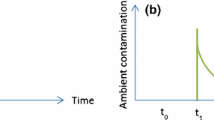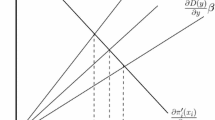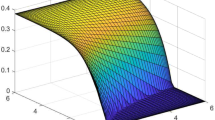Abstract
We introduce learning in a dynamic game of international pollution, with ecological uncertainty. We characterize and compare the feedback non-cooperative emissions strategies of players when the players do not know the distribution of ecological uncertainty but they gain information (learn) about it. We then compare our learning model with the benchmark model of full information, where players know the distribution of ecological uncertainty. We find that uncertainty due to anticipative learning induces a decrease in total emissions, but not necessarily in individual emissions. Further, the effect of structural uncertainty on total and individual emissions depends on the beliefs distribution and bias. Moreover, we obtain that if a player’s beliefs change toward more optimistic views or if she feels that the situation is less risky, then she increases her emissions while others react to this change and decrease their emissions.

Similar content being viewed by others
Notes
For instance, according to the IPCC’s Fifth Assessment Report, “warming of the climate system is unequivocal” (see, IPCC 2013, SPM-12).
Note that the dynamic maximization of a non-learning player is identical to an adaptive-learning player who at any point in time ignores future learning possibilities when making a decision and then suddenly realizes her mistake and updates the decision. Hence, an adaptive learner is synonymously called a bounded-rational player, or a myopic player. Anticipated utility is another term that is sometimes used for our non-learning case; see, e.g., Cogley and Sargent (2008). This term is adapted from Kreps (1998).
Qualitatively similar results hold when using a normal distribution.
For example in case of learning an individual’s self-induced effect is
$$\begin{aligned} \frac{2+\left( N-2\right) \gamma }{2+\left( N-1\right) \gamma }\beta _{i}\left( \int _{\Theta }\frac{\mu \left( \theta \right) }{1-\delta d\mu \left( \theta \right) }\xi _{i}^{1}(\theta ){\mathbf {d}}\theta -\int _{\Theta } \frac{\mu \left( \theta \right) }{1-\delta d\mu \left( \theta \right) }\xi _{i}^{2}(\theta ){\mathbf {d}}\theta \right) , \end{aligned}$$the outsider effect is
$$\begin{aligned} \frac{\gamma }{2+\left( N-1\right) \gamma }\sum _{j\ne i}\beta _{j}\left( \int _{\Theta }\frac{\mu \left( \theta \right) }{1-\delta d\mu \left( \theta \right) }\xi _{j}^{1}(\theta ){\mathbf {d}}\theta -\int _{\Theta }\frac{\mu \left( \theta \right) }{1-\delta d\mu \left( \theta \right) }\xi _{j}^{2}(\theta ){\mathbf {d}}\theta \right) . \end{aligned}$$See Masoudi and Zaccour (2014) for a proof of this statement in the simpler case where uncertainty is only in \(\beta \).
We wish to thank the Reviewer who suggested this extension. The last lines are in his/her own words.
Notice that the second-order condition is satisfied for the model.
References
Agbo M (2014) Strategic exploitation with learning and heterogeneous beliefs. J Environ Econ Manag 67(2):126–140
Arrow KJ, Fisher AC (1974) Environmental preservation, uncertainty, and irreversibility. Q J Econ 88(2):312–319
Baker E (2005) Uncertainty and learning in a strategic environment: global climate change. Resour Energy Econ 27(1):19–40
Benchekroun H, Long NV (1998) Efficiency-inducing taxation for polluting oligopolists. J Public Econ 70(2):325–342
Bramoullé Y, Treich N (2009) Can uncertainty alleviate the commons problem? J Eur Econ Assoc 7(5):1042–1067
Breton M, Sbragia L (2011) Learning under partial cooperation and uncertainty. Cahier du GERAD G-2011-46
Cogley T, Sargent TJ (2008) Anticipated utility and rational expectations as approximations of Bayesian decision making. Int Econ Rev 49(1):185–221
de Zeeuw A, Zemel A (2012) Regime shifts and uncertainty in pollution control. J Econ Dyn Control 36(7):939–950
Dellink R, Finus M (2012) Uncertainty and climate treaties: Does ignorance pay? Resour Energy Econ 34(4):565–584
Dockner EJ, Long NV (1993) International pollution control: cooperative versus noncooperative strategies. J Environ Econ Manag 25(1):13–29
Hoel M, Schneider K (1997) Incentives to participate in an international environmental agreement. Environ Resour Econ 9(2):153–170
IPCC (2013) Climate change 2013: the physical science basis. Summary for policymakers
Jørgensen S, Martín-Herrán G, Zaccour G (2010) Dynamic games in the economics and management of pollution. Environ Model Assess 15(6):433–467
Kolstad C, Ulph A (2008) Learning and international environmental agreements. Clim Change 89(1–2):125–141
Kolstad C, Ulph A (2011) Uncertainty, learning and heterogeneity in international environmental agreements. Environ Resour Econ 50(3):389–403
Kolstad C (1996) Learning and stock effects in environmental regulation: the case of greenhouse gas emissions. J Environ Econ Manag 31(1):1–18
Kolstad C (2007) Systematic uncertainty in self-enforcing international environmental agreements. J Environ Econ Manag 53(1):68–79
Koulovatianos C, Mirman LJ, Santugini M (2009) Optimal growth and uncertainty: learning. J Econ Theory 144(1):280–295
Kreps D (1998) Anticipated utility and dynamic choice. In: Jacobs DP, Kalai E, Kamien M (eds) Frontiers of research in economic theory. Cambridge University Press, Cambridge, pp 24–274
Long NV (1992) Pollution control: a differential game approach. Ann Oper Res 37(1):283–296
Masoudi N, Zaccour G (2014) Emissions control policies under uncertainty and rational learning in a linear-state dynamic model. Automatica 50(3):719–726
Mirman LJ, Santugini M (2014) Learning and technological progress in dynamic games. Dyn Games Appl 4(1):58–72
Pindyck RS (2000) Irreversibilities and the timing of environmental policy. Resour Energy Econ 22(3):13–159
Pindyck RS (2007) Uncertainty in environmental economics. Rev Environ Econ Policy 1(1):45–65
Pindyck RS (2012) Uncertain outcomes and climate change policy. J Environ Econ Manag 63(3):289–303
Ulph A, Maddison D (1997) Uncertainty, learning and international environmental policy coordination. Environ Resour Econ 9(4):451–466
Ulph A, Ulph D (1997) Global warming, irreversibility and learning. Econ J 107(442):636–650
Van der Ploeg F, de Zeeuw A (1992) International aspects of pollution control. Environ Resour Econ 2(2):117–139
Yeung DWK, Petrosyan LA (2008) A cooperative stochastic differential game of transboundary industrial pollution. Automatica 44(6):1532–1544
Author information
Authors and Affiliations
Corresponding author
Additional information
We would like to thank the Editor and two anonymous Reviewers for their helpful comments.
Appendix
Appendix
1.1 Proof of Proposition 1
Denote by \({v_{i}^{I}}\left( S;\theta ^{*}\right) \) the value function of player \(i\), where the superscript \(I\) refers to an informed player. The Hamilton–Jacobi–Bellman (HJB) equation is given by
Considering the linear-state structure of our model, we conjecture that the value function is linear and specified as follows:
Plugging the conjectured value function in (50), we obtain
The first-order equilibrium condition is given byFootnote 8
To find the coefficients of the value function, we substitute for \({e_{i}^{I}}\) in (29) and equate the coefficients in order of \(S\). This leads to a system of \(2N\) equations (2 equations for each player) and \(2N\) unknowns (\({\kappa _{i,1}^{I}}\) and \(\kappa _{i,2}^{I}\,\forall i=1,2\)), that is,
Since \(\mu (\theta ^{*})=\int _{\mathcal {H}} \eta \phi (\eta |\theta ^{*}){\mathbf {d}}\eta \), from (31), we get
and from (32)
To solve for \(\left\{ {e_{i}^{I}}\right\} _{i=1}^{N}\) rewrite (30) as a function of total emissions, \(\sum _{j=1}^{N}e_{j}\), i.e.,
and consequently, the best reaction function of player \(i\) is
We first solve for \(\sum _{j=1}^{N}e_{j}\). Summing 35 over \(i\) yields
So that total emission is
By rearranging we have
1.2 Proof of Proposition 2
By virtue of our linear-state model we conjecture that the value function of player \(i\) has the linear form of \(v_{i}^{L}={\kappa _{i,1}^{L}}(\xi _{i})S+ {\kappa _{i,2}^{L}}(\xi _{1},\ldots ,\xi _{N})\). Replacing this conjectured \(v_{i}^{L}\) in the HJB equation, we obtain
From the first-order conditions we have
Plugging (41) into (40) and equating the coefficients in order of \(S\), we have the following system of equations:
We claim that
and consequently
To show this, let us update (44) for one period to obtain
Using (8), we get
Plugging this back into (42) leads to
This corresponds to our claim. To solve for \(\left\{ {e_{i}^{I}}\right\} _{i=1}^{N}\)rewrite (41) as a function of total emissions, \(\sum _{j=1}^{N}e_{j}\), i.e.,
So, for \(i=1,\ldots ,N\),
We first solve for \(\left\{ {e_{i}^{L}}\right\} _{i=1}^{N}\), then for \({e_{i}^{L}}\). Summing (47) over \(i\) yields
So, total emissions is given by
Plugging (48) into (47) yields
1.3 Proof of Proposition 3
We follow the same procedure as we did for a learner player. We conjecture that \({v_{i}^{ NL}},\) which satisfies (12), has the linear form \({v_{i}^{ NL}}=\kappa _{i,1}^{ NL}(\xi _{i})S+ {\kappa _{i,2}^{ NL}}(\xi _{1},\ldots ,\xi _{N})\). Rewriting (12) with our conjectured value function we have
The first-order condition for \(i\) is
and since \(\int _{\mathcal {H}}\eta \phi (\eta |\theta ){\mathbf {d}} \eta =\mu (\theta )\), we obtain
Plugging (52) into (50) gives the following system of equations
and
or
We now show that \(\kappa _{i,1}^{ NL}(\xi _{i})=\frac{-\beta _{i}}{1-\delta d\int _{\Theta }\mu (\theta )\xi _{i}(\theta ){\mathbf {d}}\theta }.\) Inserting this guessed form into (55), we get
To complete the proof, rewrite (51) as a function of total emissions, i.e.,
We first solve for \(\sum _{j=1}^{N}{e_{j}^{ NL}}\), then for \({e_{i}^{ NL}}\). Summing (61) over \(i\) yields
So total emissions is given by
Plugging this back in (61) yields
1.4 Proof of Proposition 4
We have
Since \(R\) is an increasing convex function, by Jensen’s inequality we have
that is, \(\sum _{i=1}^{N}\left( {e_{i}^{L}}-e_{i}^{A}\right) <0,\) or
1.5 Proof of Proposition 5
If \(\beta _{i}=\beta \) and \(\xi _{i}(\theta )=\xi (\theta ),\,\forall i=1,\ldots ,N\), then
Let \(R\left( x\right) =x\left( 1-\delta dx\right) ^{-1}\), then
and
Since \(0<\delta ,d<1\), and \(0<\mu (\theta )<1\), then \(R\) is an increasing convex function for acceptable values of our model parameters (\(R^{\prime }>0,\,R''>0,\,\forall x\in [0,1]\)), then by Jensen’s inequality we have
Since \(\frac{1}{2+\left( N-1\right) \gamma }\) is positive, then
1.6 Proof of Proposition 8
Let \(G\left( x\right) =\frac{1}{1-\delta dx}\), which is an increasing convex function for \(0<x<1\), then we can rewrite \({\kappa _{i,1}^{L}}(\xi _{i})\) and \( \kappa _{i,1}^{ NL}(\xi _{i})\) as follows
then by Jensen’s inequality we have
that yields
1.7 Proof of Proposition 10
Let \(R\left( x\right) =x\left( 1-\delta dx\right) ^{-1}\) and \(u\left( x\right) =R\left( \mu \left( x\right) \right) \). Since, \(\mu \in \left[ 0,1 \right] ,\,R\) is increasing, and
Recall that the individual’s emissions for an non-learner player are given by equation 10, and the total emissions by
Using definition 1 and conditions (67), confirm the results for an non-learner player.
For the adaptive-learning case, an individual’s emissions are given by (14), and the total emissions are as follows:
Besides, if \({\xi _{i}^{1}}(\theta )\succ _{1}{\xi _{i}^{2}}\left( \theta \right) \), then \(\int _{\Theta }{\xi _{i}^{1}}(\theta )\mu (\theta )d \theta >\int _{\Theta }{\xi _{i}^{2}}(\theta )\mu (\theta )d\theta \) if \(\mu ^{\prime }>0\), which gives the results presented in the Proposition for the adaptive learner.
1.8 Proof of Proposition 12
We assumed \(\mu ^{\prime }>0\). If \(\mu ''\ge 0\), then since \(R\) is also increasing and convex, \(R(\mu (\theta ))\) would be an increasing convex function. Given that \({\xi _{i}^{1}}(\theta ) \succ _{2}{\xi _{i}^{2}}(\theta )\), we will have
Now, assume that \(\mu \) is a concave function, \(\mu ^{\prime \prime }\le 0\), and player \(i\)’s beliefs change from \({\xi _{i}^{1}}(\theta )\) to \({\xi _{i}^{2}}(\theta )\), with \({\xi _{i}^{1}}(\theta ) \succ _{2}{\xi _{i}^{2}}(\theta )\), that is, \(\theta ^{1}\) is less volatile than \(\theta ^{2}\) meaning that \(\theta ^{1}\succ _{2}\theta ^{2}\), then \(\mu \left( \theta ^{1}\right) \succ _{2}\mu \left( \theta ^{2}\right) \). Consequently, the inequality (70) is satisfied.
Rights and permissions
About this article
Cite this article
Masoudi, N., Santugini, M. & Zaccour, G. A Dynamic Game of Emissions Pollution with Uncertainty and Learning. Environ Resource Econ 64, 349–372 (2016). https://doi.org/10.1007/s10640-014-9873-x
Accepted:
Published:
Issue Date:
DOI: https://doi.org/10.1007/s10640-014-9873-x




